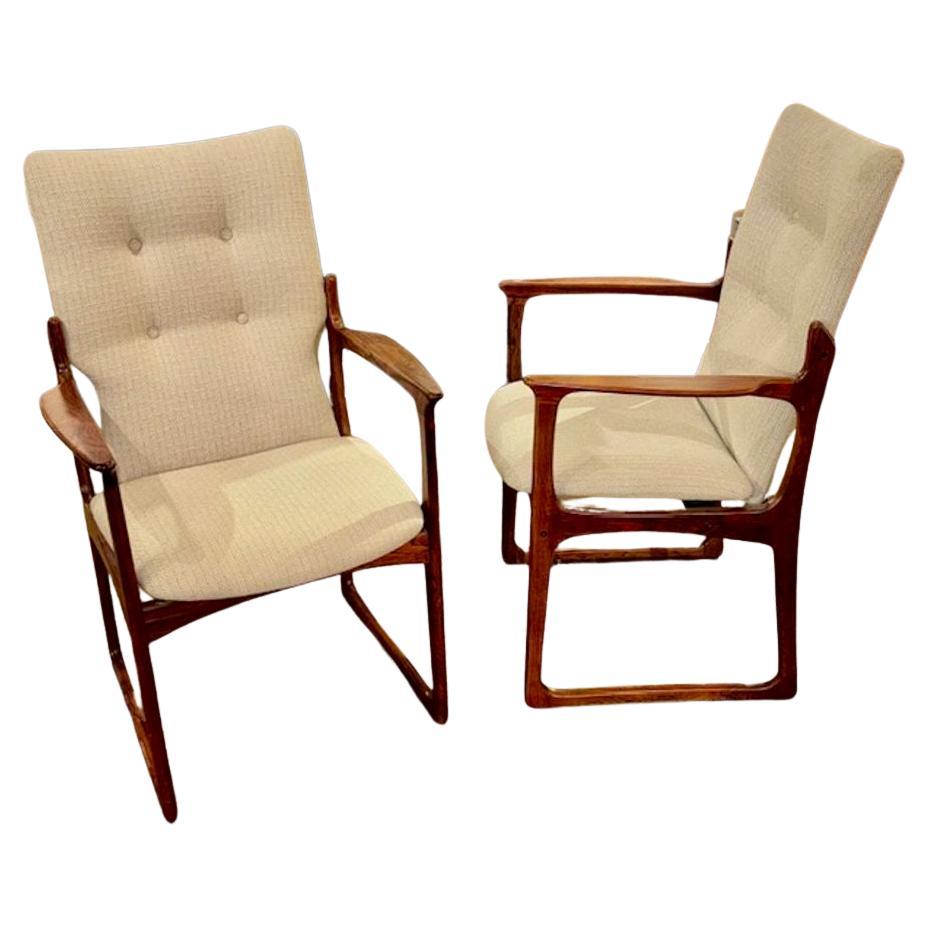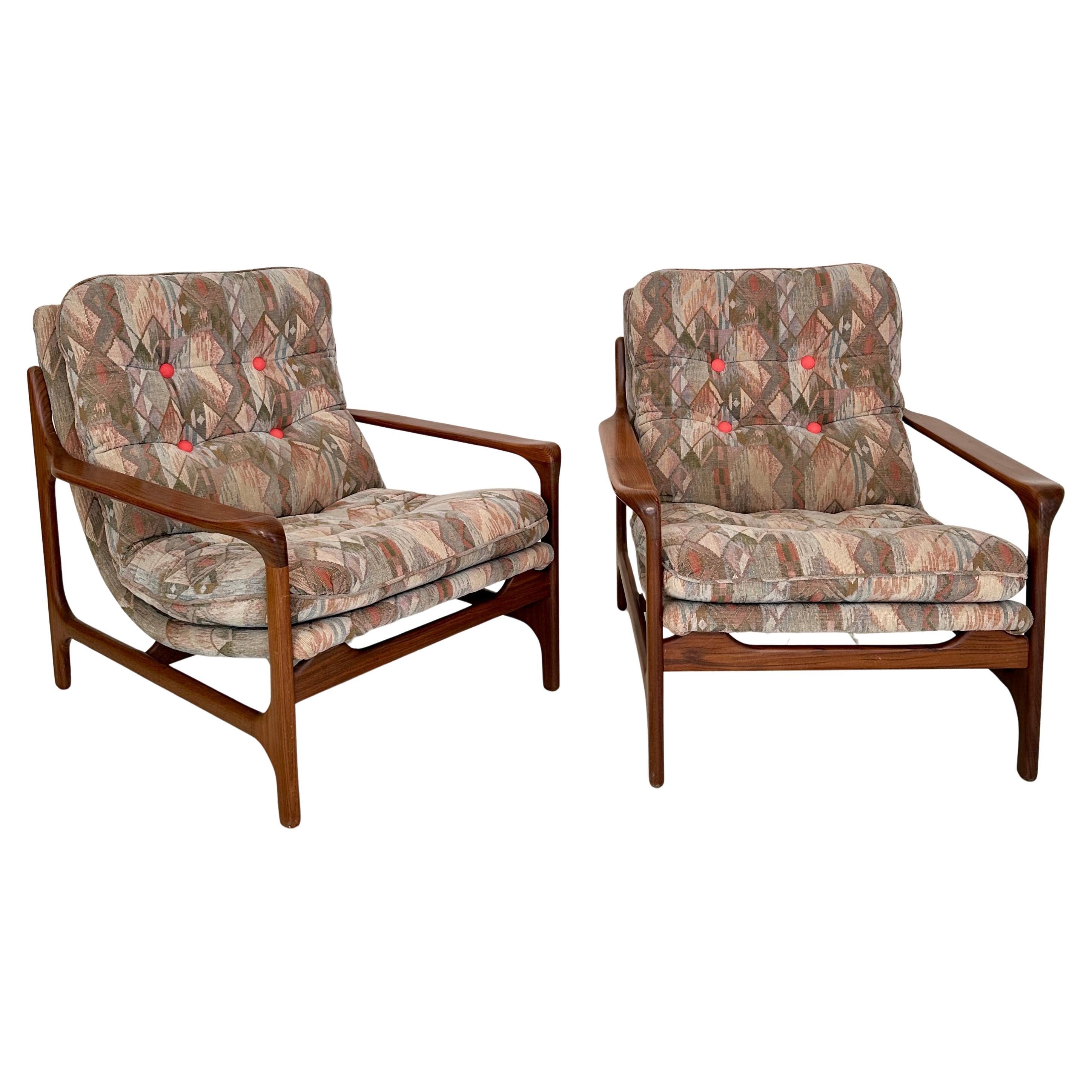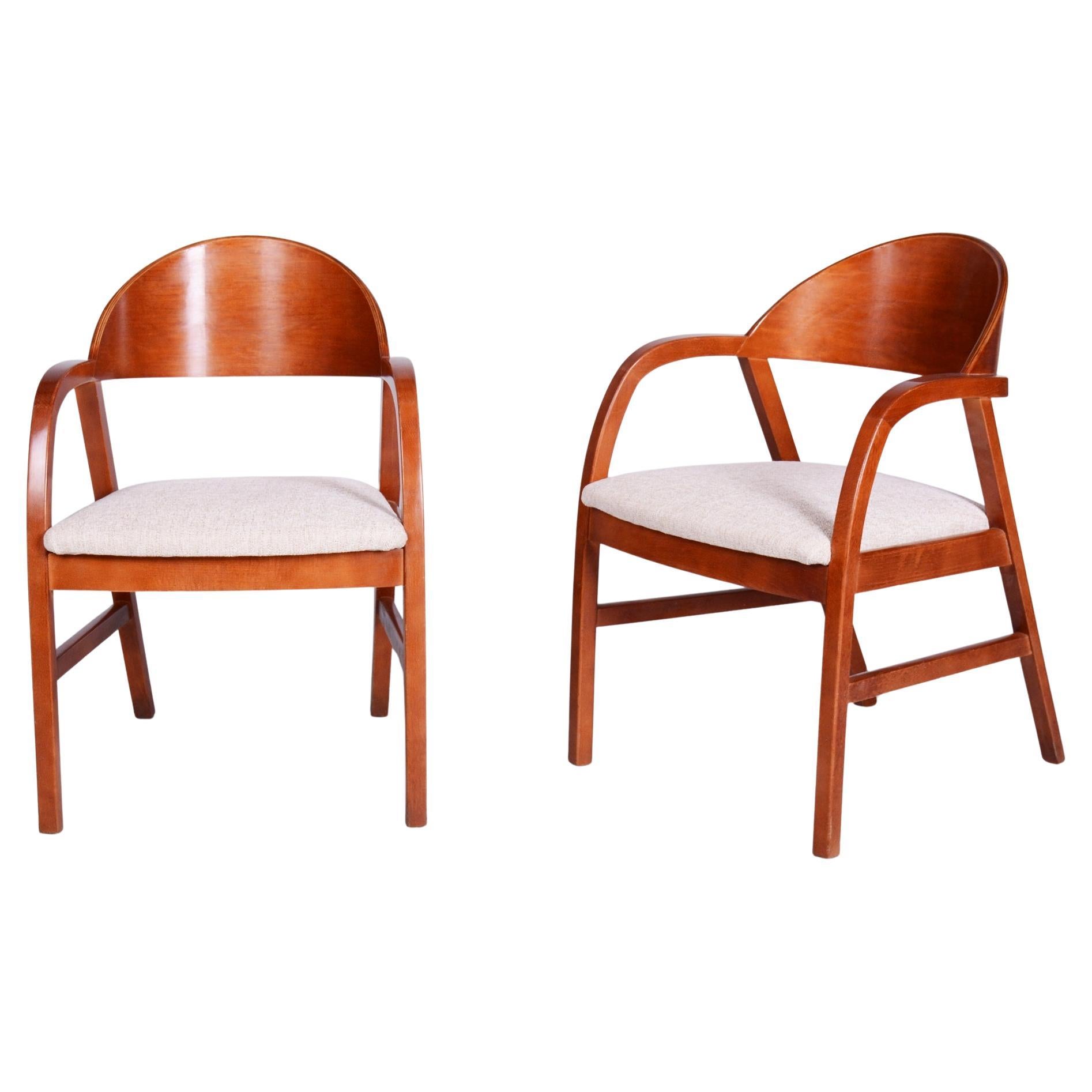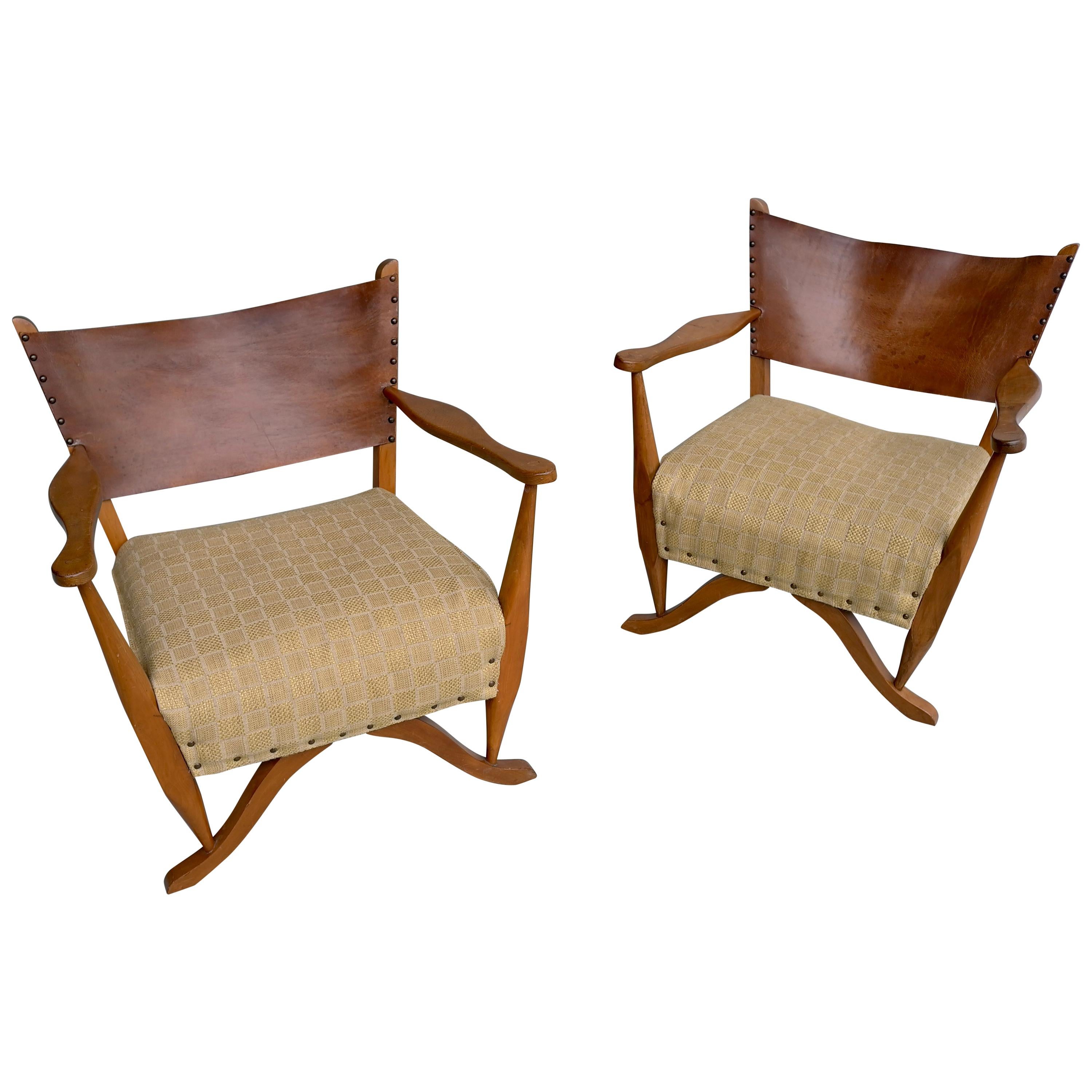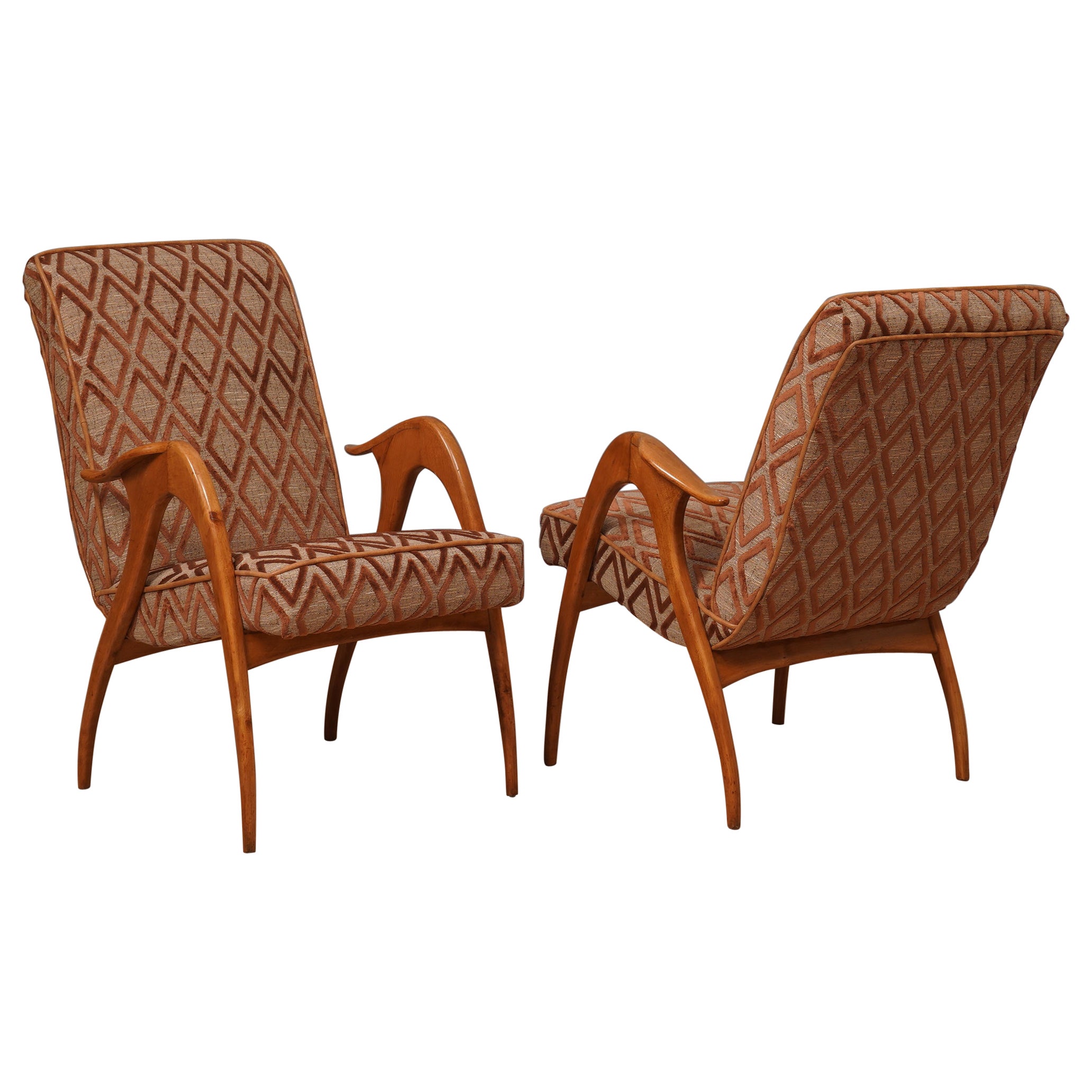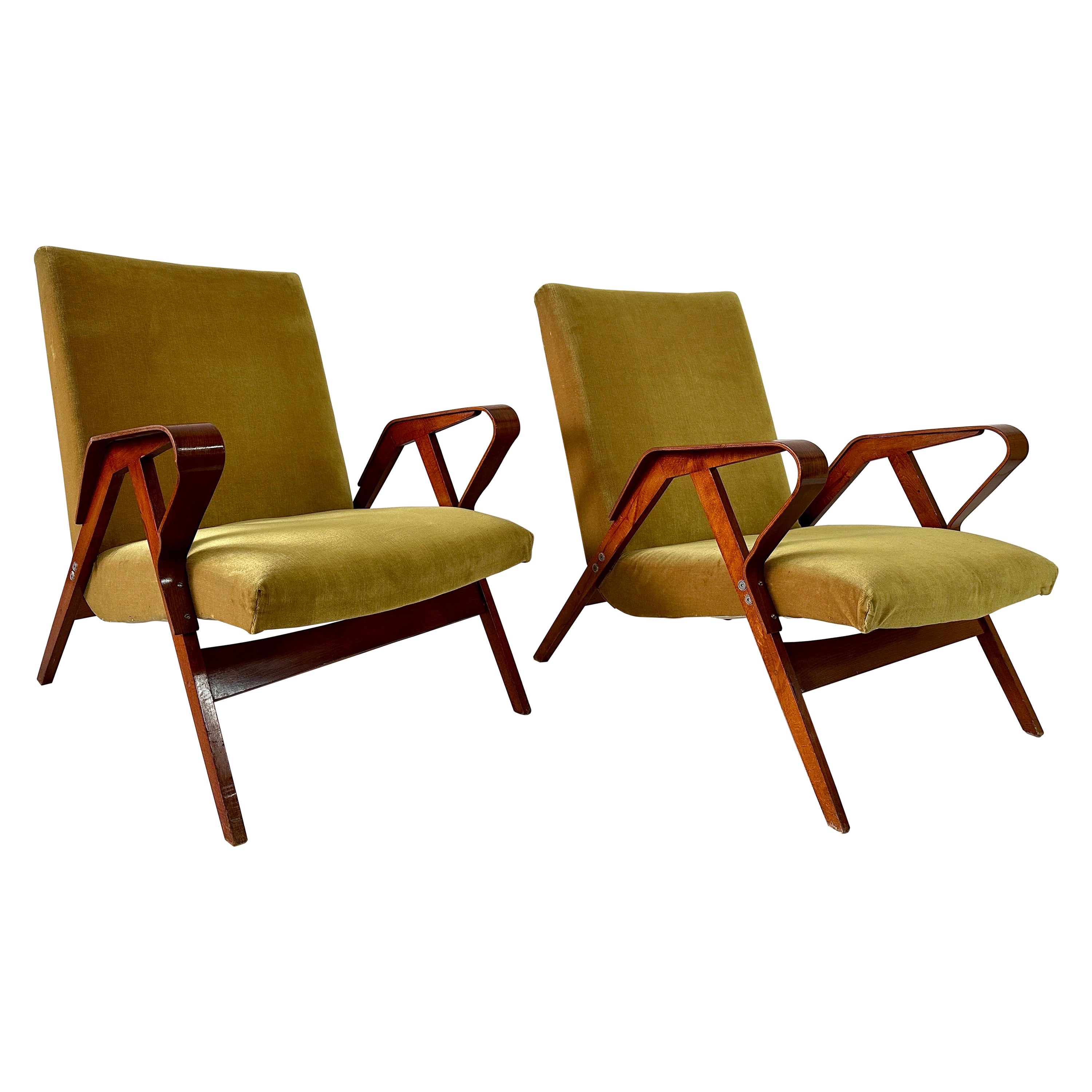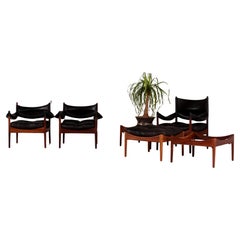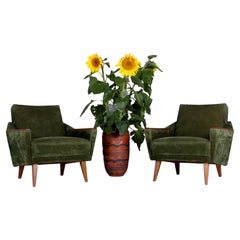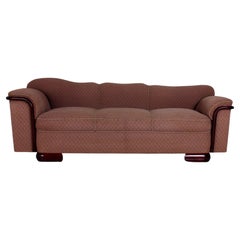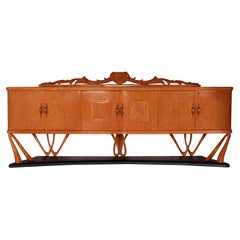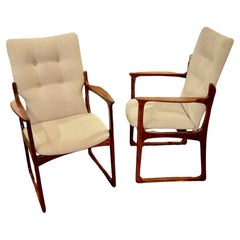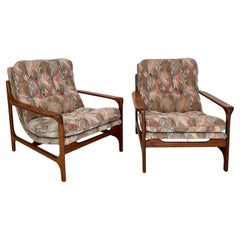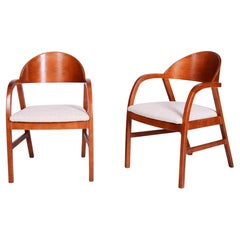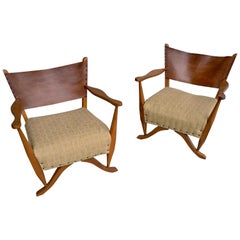Items Similar to Midcentury set of 2 solid cherry wood wingback armchairs & sofa Karl Nothhelfer
Want more images or videos?
Request additional images or videos from the seller
1 of 20
Midcentury set of 2 solid cherry wood wingback armchairs & sofa Karl Nothhelfer
$14,774.39per set
£10,958.67per set
€12,400per set
CA$20,231.09per set
A$22,493.11per set
CHF 11,773.78per set
MX$275,870.50per set
NOK 149,910.05per set
SEK 141,532.86per set
DKK 94,383.53per set
Shipping
Retrieving quote...The 1stDibs Promise:
Authenticity Guarantee,
Money-Back Guarantee,
24-Hour Cancellation
About the Item
just beautiful
SET of Sofa & 2 Wingback Armchairs
by Prof. Karl Nothelfer - Designed in 1957
maker: Schörle & Gölz in Stuttgart - Bad Cannstatt
solid Cherry Wood
new upholstery and fabrics in 1998 according to last owner ( since then just in use for 2 years so upholstery is perfect ! )
Seatrests can be removed - and fixed by clips on belts
- high class -
measurements:
easy chair is 70cm wide ~ sofa is 178cm wide
both: seating height 40cm ~ seating depth: 57cm
condition - all firm and in very good condition - no damages
furniture have fully been accurately cleaned ::
- 3 steps: A: air pistol - B: industrial hoover - C: latest Kärcher "wash&hoover" technology
- woods have been polished several times
note: please ask for shipping quote by sending us your postcode/destination
Prof. Karl Nothelfer
* 14 June 1900 ~~ + 20 May 1980
Since the beginning of the 15th century, the Nothelfer family of carpenters has been continuously resident in the former
town of Überlingen without interruption. Every carpenter at that time mastered
all the possibilities of woodworking: so did the Nothelfer. They could carpenter,
even carve altars and figures, and set them in gold, silver and paint.
(churches in Owingen and Hödingen]. Some family members lived and worked
and worked in Hedingen or Hödingen,like today the jubilarian Karl Nothelfer (this in 1975).
His father, Karl Anton Nothelfer, as the eldest of seven siblings, was able to take over his father's carpentry business in Überlingen.
Karl Anton Nothelfer, the eldest of seven siblings, was unable to take over his father's carpentry business in Überlingen.
He instead moved to the industrial town of Singen with his young wife Rosalie, née Hanner, from the
from Hohenzollern in 1896 and moved to the former Poststraße and founded his own carpenter's workshop.
He had a highsense of quality and form and was already a member of the German Werkbund before 1914.
Karl Nothelfer and his three siblings grew up in such air.
After attending school and the secondary school in Singen, the young Karl learned the carpenter's trade in his father's workshop then moved on to the Badische Landes-Kunstschule in Karlsruhe,
where he studied architecture. At that time the well-known furniture professor also worked there
Fritz Spannagel, born in Freiburg in 1891, who settled in 1938 at Ittendorf Castle near Meers-
burg (died 1957). In 1928, the gifted young architect received a teaching assignment at the
at the Karlsruhe School of Art, but followed his teacher Spannagel to Berlin in the same year.
Berlin. Here he worked from 1928-1945 as a teacher - appointed professor in 1931 - at the
Berlin Tischler-Schule, the later Bauschule für Raumgestaltung.
The furniture he created in Berlin became internationally known through many exhibitions and lectures.
nationally known and influential. His furniture creations ushered in a new era in German and
a new era in German and European furniture design. At the world exhibition in Paris
1937 Prof. Nothelfer was awarded the Golden Medal for his work in the furniture sector.
for his work in the furniture sector. A first summary and balance of his work on furniture is given in his standard work
1942 published standard work "Das Sitzmöbel", the first compendium of its kind in the world.
world. In 1950 he published his second work "Furniture". Both books and a
series of brochures were published by Verlag Otto Maier, Ravensburg.
Karl Nothelfer continued to work intensively on the design of seating furniture in the years after 1945.
In 1950 he succeeded in the important invention of the two-legged skid-base chair, which has been
orthopedically - anatomically tested thousands of times - has become accepted all over the world today.
Even the most distinguished American furniture companies such as Miller or Knoll-International
use the skid as the main theme for desks and chairs. At the same time, N. had a groundbreaking
in the redesign of German school furniture and seating for industry.
industry. He succeeded in adapting his furniture forms, which originated in wood and handicraft, to the modern technical
modern technical possibilities of the industry. He thus became the great refor-
of schoolroom furnishings. The architect Nothelfer thinks about himself,
that he made his main contribution in the field of seating furniture, although this was not
was not really his profession.
After the war, Prof. Nothelfer, like so many others, had to start all over again. He settled
settled in his home town of Lake Constance in Hödingen in 1945 as a freelance architect and was
and was involved in all areas of construction in the years after the war. As early as 1935, he had given many
the example of American prefabricated buildings and recommended serial house
and recommended it at a time when no one in Germany was even thinking about mass production. Now he developed
he developed several types of mass-produced houses, which were manufactured in Baiersbronn.
of which more than 800 houses were built in France alone (types Paris, Provence, Normandie).
were built. At that time [1946], as part of the reparations in Strasbourg, there was an exhibition of houses with Swedish, Danish, and French designs.
with Swedish, Danish, Finnish, English and German houses, where the French occupation
for which 6 different types were sent from the French occupation zone, the
Nothelfer's house type was considered the top of this exhibition.
Karl Nothelfer was also involved in the development of chipboard. In 1946, together with others in Munich, he founded the first
magazine "Bauen und Wohnen" ("Building and Living") after the war and remained its co-editor for many years.
co-editor of this magazine for many years. By presenting his own work, he has here
interpreted what the essence of the magazine wanted to be: Building, in order to live in it, in order to live as a human being and humanly in the built. Karl Nothelfer planned his houses
furniture ground plan, from the need for living. In 1948 he was appointed honorary senator of the State Building
school in Holzminden.
Karl Nothelfer did not build much in Singen. The first post-war house was Haus
Fahr on the slope of the Hohentwiel (Domäne); the building material came from a demolished
log house that a French officer had built for himself on the Schie- nerberg.
nerberg. In 1952, he also built the administration building of the aluminum rolling mill in Singen.
rolling mills in Singen, with relief and wall painting by C. G. Becker. In Überlingen he built
In Überlingen he built, among others, the Buchinger Sanatorium, the Riese+ Hähnel radio house and
various reconstructions in the old town: Haus Kitt with the Glockenspiel, the Haus mit dem
Bacchus in the Überlingen village, the Dolphin Fountain in Hödingen (1975). Probably the most beautiful
Haus Nothelfers, the Haus Himmelheber, stands in Baiersbronn-Tonbach. On the airfield
Mengen, Nothhelfer built the casino building with the 30 square meter faience painting Ikarus by
C. G. Becker. In 1954 he founded a second office with architect Hans Schwingen in Düsseldorf.
Office, which primarily fertilized the housing construction, true to the motto:from the inside to
planning from the outside. The Minister of Housing awarded a prize to the best social housing in North Rhine-
Westphalia; it was from the Nothelfer+Schwingen studio in Düsseldorf. Also the idea of
new idea of home ownership was also promoted by Nothelfer+Schwingen.
promoted by Nothelfer+Schwingen. On the occasion of the red jubilee of the law about condominium ownership
Nothelfer gave a lecture in Essen in 1961 on condominium ownership in Europe (published as a brochure).
published as a brochure]. From Düsseldorf, among many others, in the silk city of
Krefeld: on the facade 4 mosaics, each 25 meters long "From the caterpillar to silk
from the caterpillar to silk" by the friend C. G. Becker, furthermore the Geological Institute and many
green residential areas. Nothelfer's special interest is the protection of the landscape.
In speeches and concise writings, he is committed against the freeway route near the lake.
route on the northern shore of Lake Constance.
All this, however, is not the whole Nothelfer, who has remained incredibly fresh and full of
ideas. His whole love is beside the occupation the water sport, the sailing;
at the age of 60, he still acquired, together with his wife, the deep-sea sailing patent, which
which enabled them to sail extensively in the Mediterranean on their own keel.
The harvest of these
travels was a series of cultural-historical lectures with film and slides: In the Footsteps of
Odysseus.
Since 1949 Karl Nothelfer is a member (in the meantime honorary member) of the Bodensee-Yachtclub
Überlingen, which he also presided over as president from 1967-1971; he is also the house architect
of the club, who rebuilt and modernized the clubhouse and redesigned the harbor facilities in Über-
lingen was redesigned. However, we also want to mention that Karl Nothelfer, incidentally an excellent painter himself
an excellent painter himself, was and is a good friend and helper of the artists. Especially
This applies in particular to his friend Curth Georg Becker, whom he honored on October 2, 1975, at a vernissage in the
nissage at the Lake Constance Museum in Friedrichshafen. In the summer of
In the summer of 1976, he was the driving force behind and contributor to a beautiful exhibition entitled "Schöpferisches Hödin- gen.
gen". The announcement of this exhibition is a commitment to the life-enriching arts and to the homeland.
arts and to his homeland, from which, like the giant Antaeus of the Greek myth, he draws uncreative
from which, like the giant Antaeus of the Greek myth, he draws inexhaustible strength and joy.
linger See, has a varied history. For centuries it lived from winegrowing in close connection with the
connection with the Free Imperial City of Überlingen, with which it has been united for a short time.
by Herbert Berner, Singen to his 75th Birthday in 1975 - partly translated with Deepl
- Dimensions:Height: 29.14 in (74 cm)Width: 70.08 in (178 cm)Depth: 27.56 in (70 cm)Seat Height: 15.75 in (40 cm)
- Sold As:Set of 3
- Style:Mid-Century Modern (Of the Period)
- Materials and Techniques:
- Place of Origin:
- Period:
- Date of Manufacture:1957
- Condition:Rewoven. Minor fading.
- Seller Location:Landshut, DE
- Reference Number:1stDibs: LU8587235777342
About the Seller
5.0
Gold Seller
Premium sellers maintaining a 4.3+ rating and 24-hour response times
1stDibs seller since 2023
21 sales on 1stDibs
Typical response time: 2 hours
- ShippingRetrieving quote...Shipping from: Bodenkirchen , Germany
- Return Policy
Authenticity Guarantee
In the unlikely event there’s an issue with an item’s authenticity, contact us within 1 year for a full refund. DetailsMoney-Back Guarantee
If your item is not as described, is damaged in transit, or does not arrive, contact us within 7 days for a full refund. Details24-Hour Cancellation
You have a 24-hour grace period in which to reconsider your purchase, with no questions asked.Vetted Professional Sellers
Our world-class sellers must adhere to strict standards for service and quality, maintaining the integrity of our listings.Price-Match Guarantee
If you find that a seller listed the same item for a lower price elsewhere, we’ll match it.Trusted Global Delivery
Our best-in-class carrier network provides specialized shipping options worldwide, including custom delivery.More From This Seller
View AllMODUS by Kristian Solmer Vedel SET of 3 lounge chairs 1 stool & 2 coffee tables
By Kristian Solmer Vedel
Located in Landshut, BY
This set was designed by Kristian Solmer Vedel for the renowned Søren Willadsen Møbelfabrik in Denmark.
It boasts excellent original condition.
The set includes two lounge armchair...
Category
Vintage 1960s Danish Scandinavian Modern Stools
Materials
Aluminum
pair of 1960s lounge chairs green velvet - beech WG solid make uph. easy chairs
Located in Landshut, BY
This set of two West German lounge chairs is in very good condition
It was made in the mid 1960s
The armrests have been professionally restored (sanded - stained and lacquered tw...
Category
Mid-20th Century German Mid-Century Modern Lounge Chairs
Materials
Wood, Velvet, Beech
STRAIGHT classic art deco SOFA Dresden around 1930 or. fabric - wood refinished
Located in Landshut, BY
""~!~** STRAIGHT **~!~**
This classic art deco sofa was produced in the Dresden area in the 1930s
Its shape is quite unique and very well proportioned
Its spring upholstery is still strong and fully undamaged
All wooden parts have been demounted sanded and stained - then treated (sprayed) with a transparent Acrylic Silk Matt Paint
finish and professionally remounted.
The sofa has fully been accurately cleaned ::
:: 3 steps: A: air pistol...
Category
Vintage 1930s German Art Deco Sofas
Materials
Wood, Fabric, Beech
$3,622 Sale Price
33% Off
One of a Kind Italian Midcentury Sideboard with Bar Cabinet a. Vittorio Dassi
By Vittorio Dassi
Located in Landshut, BY
Italian 1950s
one of a kind
BAR / SIDEBOARD
attributed to Vittorio Dassi
birch root veneer - solid birch "feet" - stained glass top - mirrored bar compartment - carved upper orna...
Category
Vintage 1950s Italian Mid-Century Modern Sideboards
Materials
Stained Glass, Birch, Burl
Björn Wiinblad for Rosenthal limited art series dining room set table & 8 chairs
By Bjorn Wiinblad
Located in Landshut, BY
THE FOUR CARDINAL POINTS
Rosenthal Kunstmöbelreihe
This noteworthy design is the work of Bjørn Wiinblad.
The furniture pieces were produced in a limited edition of 300 in 1976.
E...
Category
Vintage 1970s German Space Age Dining Room Sets
Materials
Wood, Beech, Bentwood, Lacquer
art nouveau oak stool chair Jugendstil Rabenau embroidery a. 1910 exc condition
Located in Landshut, BY
solid built oak
Jugendstil
CHAIR
made in Rabenau / Saxonia
upholstered with care - fitted with hand embroidered jute fabric
Rabenau's chairmaking tradition is almost 400 years ol...
Category
Vintage 1910s German Art Nouveau Chairs
Materials
Wool, Jute, Oak
You May Also Like
Pair of Mid Century Modern Rosewood Danish Armchairs
Located in Dallas, TX
Nice pair of mid-century modern rosewood Danish armchairs from the 1960s. These vintage chairs perfectly capture the retro and mid-century style popular during that time period. Made...
Category
Mid-20th Century Danish Mid-Century Modern Armchairs
Materials
Rosewood
Mid Century Pair of Armchairs in Teak in the Style of Eugen Schmidt, around 1960
By Eugen Schmidt
Located in Berlin, DE
This stylish pair of mid-century armchairs, crafted around 1960, reflects the refined modernism characteristic of Eugen Schmidt’s design aesthetic. Made from beautifully grained teak...
Category
Vintage 1960s German Mid-Century Modern Armchairs
Materials
Upholstery, Teak
Pair of Restored Mid-Century Armchairs, Reupholstered, Cherry Wood, Czech, 1970s
Located in Brandys nad Labem, Středočeský kraj
This elegant pair of Mid-Century armchairs comes from Czechoslovakia from the second half of the 20th century. They are made of solid beech with cherry veneer.
The armchairs have un...
Category
Vintage 1970s Czech Mid-Century Modern Armchairs
Materials
Fabric, Upholstery, Wood, Lacquer, Cherry
Pair of Mahogany Armchairs with Natural Sling Leather Back, Denmark, 1960s
Located in Den Haag, NL
Pair of mahogany armchairs with natural sling leather back, Denmark 1960s.
Category
Mid-20th Century Danish Mid-Century Modern Armchairs
Malatesta e Mason Beech Wood and Fabric MidCentury ArmChairs, 1950
By Malatesta and Mason
Located in Rome, IT
Icon of the Malatesta and Mason company, these armchairs are a project that has characterized and influenced all the seats of the last century. Amazing design and amazing comfort.
T...
Category
Vintage 1950s Italian Mid-Century Modern Armchairs
Materials
Velvet, Beech
Mid-Century Modern Pair of Bentwood Armchairs, Czechoslovakia 1950
Located in North Miami, FL
These very chic Czechoslovakian mid-century modern armchairs with bent wood frame in slats and geometric curves. VERY VERY comfortable and perfect lo...
Category
Vintage 1950s Czech Mid-Century Modern Armchairs
Materials
Fabric, Bentwood
